
Catalog excerpts

Holographic Radar / White Paper Holographic Radar - See everywhere, all of the time Holographic Radar is a unique hardware platform on which almost limitless software defined applications can be built - it represents a new paradigm in surveillance technology Radar technology has been with us for over seventy years, yet many of the fundamental elements of radar design have changed little over that time. The vast majority of surveillance radars are based on mechanical scanning - a rotating antenna which sends out a pulse of radio waves, receives the echo and so can calculate the range and direction of a target. This gives the classic "blip" on a radar screen every few seconds. More advanced electronically scanned array radars, which can steer and point a radar beam without using moving parts, have since been developed and are widespread in military applications. However they are typically considered expensive and whilst more flexible than traditional radar they remain scanning systems. Towards the end of the 20th century, leaders in the field of radar including the renowned radar scientist Merrill Skolnik began to propose a fundamentally different and far more advanced concept - a radar that constantly looked in all directions, all of the time. This kind of ubiquitous radar would theoretically have huge benefits over traditional designs, with no moving parts, the ability to detect and track multiple targets simultaneously, higher sensitivity and the intrinsic ability to give full three dimensional positions. The principal barrier at the time to creating such a radar was the huge processing power that would be required to handle the vast amount of data that comes from continuously looking in all directions. This was far beyond the computing technology of the time, meaning ubiquitous radar remained a fascinating but impractical theoretical concept. Digitising the airspace Step forward 20 years, and the processor power now available and affordable for civil applications has increased exponentially. These advances, coupled with ground-breaking design work conducted by the world leading engineers at Cambridge Consultants, have allowed Aveillant to produce the first family of products based on the ubiquitous radar concept - the Holographic Radar
Open the catalog to page 1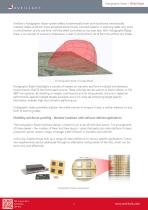
Holographic Radar / White Paper Aveillant's Holographic Radar system differs fundamentally from both traditional mechanically scanned radars and from more advanced electronically scanned systems. A scanning radar only looks in one direction at any one time, with the dwell controlled by the scan rate. With Holographic Radar, there is no concept of scanning whatsoever, it sees in all directions, all of the time without any break. 3D Holographic Radar Coverage Model Holographic Radar floodlights a volume of interest on transmit, and forms multiple simultaneous receive beams that fill the...
Open the catalog to page 2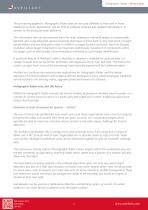
T e rcsi a pi t H lga h R d r aa a b q i df rn t ta ue i moe h po es g p ld o oo rp i a a d t cn e u e iee to h t sd n r n e c t f t dt n lytmsA pi t n cnb b i a sf ae d l a da pi i id ay rn r i ass a i o e . p lai s a e ut s ot r mo u s n p ld n v u l o i c o l w e e di l c netote atu ra a pafr . o crt h p rcl rd r l oms i a t T enomainta cnb et c df m te a a rl i t i id atress xe t n l h i r t h t a e x at r h rd re t g o n v u lag tiecpi ay f o r e o an di o l d tid a dui a vne s n l rcsi tcn u ste d ie t vr h hl e o tre eae ,n s g d a cd i apo es g eh i e il st l o ey i e l fag t l n g...
Open the catalog to page 3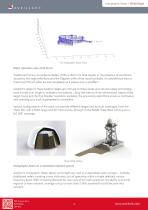
Holographic Radar / White Paper Radar operation over wind farms Traditional Primary Surveillance Radars (PSRs) suffer from false targets in the presence of windfarms, caused by the large reflections and the Doppler shifts of the rotating blades. An aircraft track from a traditional PSR will often be lost completely as it passes over a windfarm. Aveillant's range of Theia Aviation radars are immune to these issues and can accurately and reliably track aircraft over single or multiple wind turbines. Using the intrinsic three-dimensional nature of the target tracks and the fine Doppler...
Open the catalog to page 4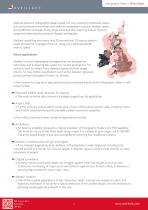
Holographic Radar / White Paper National Network Holographic Radar would not only consist of distributed radars, but would include transmitters and receivers at separate locations (bistatic radar), giving efficient coverage of very large areas and also requiring a lower dynamic range and reducing any potential Doppler ambiguities. Aveillant modelling has shown that 30 transmit and 30 receive stations could provide full coverage of the UK, using just 2 MHz bandwidth within L-band. Future applications Aveillant's current development programmes are focussed on optimising and enhancing the...
Open the catalog to page 5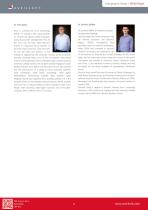
Holographic Radar / White Paper Dr. Chris Baker Chris is currently the Chief Technology Officer for Aveillant with responsibilities for all technical aspects of the companies products and their development Prior to this Chris was the Ohio State Research Scholar in Integrated Sensor Systems at the Ohio State University. Until June 2011 he was the Dean and Director of the College of Engineering and Computer Science at the Australian National University (ANU). Prior to this he held the Thales-Royal Academy of Engineering Chair of intelligent radar systems based at University College London. He...
Open the catalog to page 6All AVEILLANT LTD catalogs and technical brochures
-
3D Holographic Radar™
7 Pages
-
Holographic Radar
2 Pages
-
Theia 384A Product Sheet
2 Pages
-
Theia 64A Product Sheet
2 Pages
-
Theia 16A Product Sheet
2 Pages
-
Gamekeeper 16U Product Sheet
2 Pages







